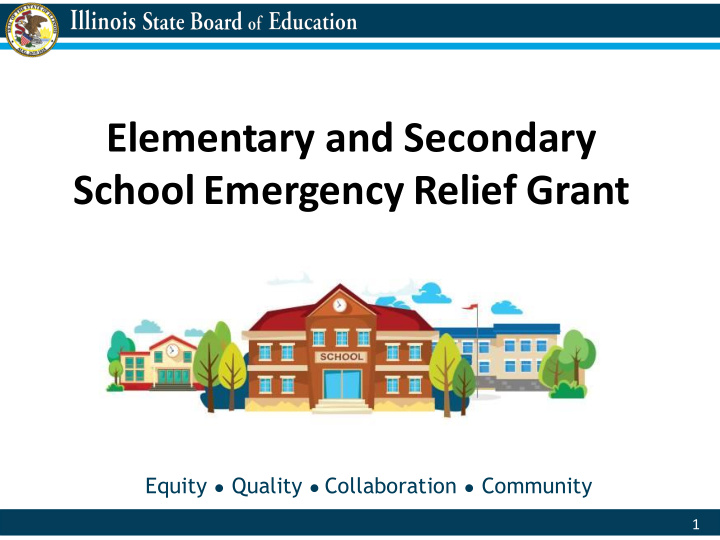



Elementary and Secondary School Emergency Relief Grant Equity ● Quality ● Collaboration ● Community 1
Purpose Equity ● Quality ● Collaboration ● Community 2
Elementary and Secondary School Emergency Relief Grant The Elementary and Secondary School Emergency Relief (ESSER) grant provides local educational agencies (LEAs), including charter schools that are LEAs. • Emergency relief funds to prevent, prepare for, and respond to the coronavirus threat. • Equitable services to students and teachers in non- public schools as required under the Coronavirus Aid, Relief, and Economic Security Act (CARES Act). Equity ● Quality ● Collaboration ● Community 3
Allowable Use of Funds 1. Activities authorized in the Every Student Succeeds Act (ESSA), Individual with Disabilities Education Act (IDEA), Carl D. Perkins Career and Technical Education Act (Perkins), and McKinney-Vento Act. 2. To address needs of low-income children or students, children with disabilities, English Learners, racial and ethnic minorities, students experiencing homelessness, and foster care youth. Funds can also be used for outreach and service delivery. 3. Providing: • Meals to eligible students. • Technology for online learning between all students and classroom teachers (including hardware, software, and connectivity). • Guidance for meeting the requirements under the IDEA and other educational services (e.g., educators providing services through digital or online platforms, counseling services, and guidance services consistent with federal, state, and local requirements). • Mental health services and supports. • Summer learning and supplemental after-school programs, including classroom instruction or online learning. 4
Allowable Use of Funds 4. Addressing needs of individual schools resulting from the coronavirus and resultant school closures. 5. Efforts between districts and other partners to develop, prevent, prepare for, and respond to coronavirus. 6. Professional development to minimize the spread of infectious diseases (e.g., sanitation training). 7. Cleaning and sanitizing school and district buildings. 8. Other activities necessary to maintain the operation and continuity of services. 5
Substantially Approvable • Reasonable : Consistent with prudent business practice and comparable current market value; • Necessary: Required to carry out the intent and purpose of the program; and • Allocable : Chargeable or assignable in accordance with relative benefits received. In addition, costs must be aligned with generally accepted accounting principles and adequately documented and budgeted within the grant. 6
Getting Started-IWAS Equity ● Quality ● Collaboration ● Community 7
Getting Started-IWAS 8
Getting Started-IWAS 9
Application 10
Overview Page 11
Applicant Information Page 12
Amendments Page 13
FFATA Page 14
Program Specific Use of Funds-Non Public 15
Nonpublic Consultation Form 16
Program Specific Use of Funds-Non Public Determine the non-public proportionate share calculation for services: • Calculate the proportionate share using: o The number of low-income students in non-public schools (ESEA Sec. 1117) and o The total number of students enrolled in non-public schools (ED Guidance 4.30.20). • LEAs will engage in consultation and non-public schools will receive the services based upon the number of low-income children (ESEA Sec. 1117) • LEAs will hold back the difference between the total ESSER LEA allocation and the amount calculated based upon total enrollment minus the low-income student proportionate share (like in an escrow account). • The lesser of the two, number of low-income students or total number of students enrolled shall be used for the delivery of initial services. • Once the approach to calculation is clarified by ED or language in the HOUSE Act, the LEA would: o Amend their grant to provide additional non-public services based upon total enrollment OR o Allocate those dollars held back for services to/for the LEA. 17
Program Specific Use of Funds-Non Public Title I Low-Income Allocation Approach ESSER Total # of low income # of low income Proportionate Share: Proportionate Share: Public School Non-public allocation Allocation students students enrolled in a Public School Non-Public School Allocation enrolled in non-public school public school $900,000 1,000 25 97.6% 2.4% $877,500 $22,500 Total Enrollment Allocation Approach ESSER Total Total number of Total Number of Proportionate Share: Proportionate Share: Public school Non-Pubic School Allocation Allocation students students enrolled in a Public School Non-Public School allocation* enrolled in non-public school public school $900,000 1,350 150 90% 10% $810,000 $90,000 18
Program Specific Use of Funds-Non Public Please keep in mind: • In the example of the last slide, the non-public would receive the lower of the two amounts or $22,500 for the initial delivery of equitable services. • There may be instances where the lower amount for equitable services results from the calculation using total enrollment. • If, there are no changes to the language in the CARES Act (Sec. 18005), then the non-public would receive an additional $67,500. • If there are changes to the language regarding non-public consultation in the HEROES Act, then the non-public school would not receive any additional funding above the $22,500. 19
Program Specific Use of Funds-Non Public 20
Program Specific Use of Funds-Non Public 21
Program Specific Use of Funds-Public 22
Program Specific Use of Funds-Public 23
Program Specific Use of Funds-Public 24
Program Specific Estimated Jobs 25
Program Specific Subcontracting 26
Program Specific Subcontracting 27
Budget Pages 28
Budget Pages 29
Program Risk Assessment, Grant Accountability Transparency Act, & Assurance Pages 30
Submit 31
Substantially Approvable • Reasonable : Consistent with prudent business practice and comparable current market value; • Necessary: Required to carry out the intent and purpose of the program; and • Allocable : Chargeable or assignable in accordance with relative benefits received. In addition, costs must be aligned with generally accepted accounting principles and adequately documented and budgeted within the grant. 32
Page Lock Control 33
Review Checklist 34
Contact Information Illinois State Board of Education Title Grants Administration Department 100 N. First Street Springfield, Illinois 62777 (217) 785-1969 FAX: (217) 785-9031 illinoiscares@isbe.net At this time, email is the best way to contact. The department will respond as quickly as possible. 35
❑ Coronavirus Aid, Relief, and Economic Security (CARES Act), Sections 18001, 18003, 18005-18008, and 15011 o ftp://help.isbe.net/webapps/eGMS/2020/CARESLegisExcerpt.pdf 36
37
Recommend
More recommend